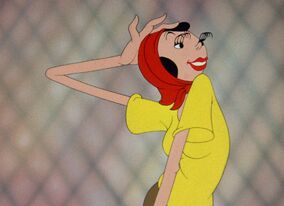| Mess Production | |
| Number 136 | |
| Guide | |
| previous For Better or Nurse |
next House Tricks? |
Mess Production is Popeye's 136th cartoon, produced in 1945 by Famous Studios.
Plot[]
Factory workers Popeye and Bluto watch as female worker Olive arrives, applying makeup. They fight to ask her out, with Bluto's ensuing victory short lived as she inadvertently gives him a hot foot and sends him flying. Later, Olive becomes trapped inside a metal drum while welding it, and Popeye succeeds in helping her. Seeing that the latter is about to be kissed, Bluto throws a metal object to hit his colleague in the head - but Olive is also struck. She goes into a dazed state, as if sleepwalking, dreaming of kissing Popeye. She walks towards all of the factory's dangerous machinery and along gigantic gears, each time narrowly missing being crushed, with the two men scrambling to save her. She is fished from danger by Popeye as she is about to walk chest-first into a giant circular saw. Later, Bluto pours molten metal on his rival, leaving him encased, while Olive treads from suspended steel beams to suspended pipes. However, Popeye is able to uncover his left foot's sole and send his spinach can out the hole and towards his pipe, for the vegetable to be sucked down. Breaking free, he beats Bluto after using the scrap metal he is thrown to make himself a tank. Popeye then catches Olive in his arms and the spell is broken when she finally gives him a passionate kiss. It is now Popeye who goes into a trance, wandering towards the same machines as her but not avoiding them: they instead break down from hitting the impervious hero.
Trivia[]
- First appearance of Olive's Famous Studios design.
- In this cartoon, Olive has an attractive and flirtatious appearance resembling Rosie the Riveter, instead of her usual, more feminine and fickle appearance.
- The title is a pun on "mass production," a common term describing the idea for reducing costs by producing large quantities of products. The products were manufactured in large factories, and often used machines to make the parts, which were assembled by workers.
Gallery[]
External links[]
- Mess Production at the Internet Movie Database


